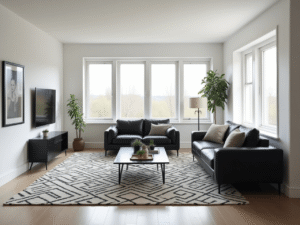The Indian market for home decor is flourishing, with the rise of disposable incomes and urbanization increasing demand in this market. The most popular items in this sector are artisanal hand-crafted and sustainable goods such as rug. These pieces do not just give homes a unique look and homes, but they also meet the ever-growing demand for environmentally friendly and unique made objects.
But before stepping foot into this booming market, you must be able to create a well-thought out business plan. A well-crafted plan will serve as your guide and help you determine your market’s needs, determine your market, control the finances and scale up operations efficiently. This step-by-step guide will guide you through the process of creating a winning carpet business strategy for India in 2025.
Understanding the Market Landscape (2025 Update)
When you start a business it is essential to know the market that you’re entering. Here’s what you must be aware of regarding your market Indian carpet market
Current Market Trends in India
- Rugs made by hand are becoming more popular and admired for their workmanship and originality.
- Sustainable and eco-friendly alternatives such as jute and recycled materials are highly sought-after and are in line with the global sustainability agenda.
- Custom-designed and customized rug are getting more popular in the eyes of buyers who want exclusive, custom-made pieces.
Target Consumer Insights
- Urban homeowners The rising middle and upper middle class wants to invest in home furnishings that are artisanal. decoration.
- Interior Designers Professionals searching for unique designs that will delight their customers.
- Hotel and Tourism Sector Hotels and resorts that require robust yet luxurious rugs for interiors.
Identify Key Competitors
Study competitors such as Jaipur Rugs, The Ambiente, and Rug Republic. Learn about their unique selling features (USPs) and figure out ways to differentiate yourself, whether it’s pricing, design or a green branding story.
Defining Your Rug Business Niche
Your niche will establish your brand’s image and establish your company’s position in the market.
Handmade vs. Machine-Made Rugs
Choose whether to focus on hand-crafted, artisanal rugs (ideal for an audience with a higher value) or made-to-order rug (suitable for an economy-conscious consumer). Hand-made rugs, such as those from hubs such as Bhadohi and Jaipur are often regarded as having more value due to their craft.
Choosing Materials
Choose a focus on a single material like:
- Wool to provide luxury and warmth.
- Jute and Cotton to reduce costs and environmental sustainability.
- Silk for premium designs that target elite customers.
Service Offerings
Your business will be focusing on:
- Custom design services for personalized rugs?
- Export possibilities in Europe and in the Middle East, or the U.S.?
- Retail local stores Perhaps in metro cities such as Delhi and Mumbai?
Business Model and Structure
Your operational model and business structure will define the way your rug business operates.
Offline vs. Offline Setup
- The Online Model A e-commerce store made using platforms like Shopify and WooCommerce.
- Offline Model Brick-and-mortar showroom in the upscale areas.
- Hybrid Model: Combining e-commerce with a select number of physical stores for greater market.
Selling Format
- Direct-to-consumer (D2C) for customized experiences.
- B2B Partnerships with hotels, real estate developers, or boutique retailers.
- Marketplace Selling on Amazon, Etsy, or Pepperfry.
Choosing a Legal Structure
- Proprietorship for a small-scale business.
- LLC (Limited Liability Partnership) to share the ownership of a limited liability.
- Private Limited Company to allow for expansion and interest from investors.
Branding & Positioning
A strong brand image is essential to stand out in a competitive market.
Establish Your Brand Identity
- Select the most memorable company name that represents your area of expertise (e.g. eco-friendly, organic or luxury carpets).
- Create a memorable brand identity as well as a story for your brand that focuses on quality and sustainability.
- Make sure you highlight your the value you bring to your customers Highlight your value proposition, for example, providing support to artisans or exclusive designs.
Packaging & Presentation
The strong packaging gives you an impression of premium quality. Consider:
- Eco-friendly or sustainable packaging that be in line with current fashions.
- In addition, you will receive care instructions and a thank-you note that will improve the experience of unboxing.
Operational Plan
Achieving efficient operations is the core of every company. Here’s how to start:
Sourcing Raw Materials
Get raw materials such as wool or cotton from hubs that are established:
- Bhadohi, Panipat, and Jaipur are known for their production of top-quality textiles.
Work with Artists
Join hands with skilled artisans in order to guarantee authenticity and top quality workmanship. Platforms such as The India Artisans Alliance can help you find talent.
Quality Control
Create standardized quality inspections to ensure that your rug meets the expectations of the market.
Marketing Strategy
Promotion is crucial to build brand awareness and attracting customers.
Digital Marketing
- Make use of SEO to get your website to rank for keywords such as “eco-friendly rugs” or “custom rugs India.”
- Engage with your followers on Instagram or Pinterest Engage on Instagram and Pinterest, since these social media platforms thrive on content that is visually appealing.
- Collaboration with influential people as well as interior design professionals who are aligned with your brand’s style.
Trade Shows & Events
Attend trade shows such as those at the India Carpet Expo or The Ambiente India to make connections and increase exposure.
Collaborations
Make use of home decor websites as well as boutiques to show your items.
Sales Channels
A well-balanced mix of sales channels can enable you to reach a variety of customers with different types of.
- Your own site The use of platforms such as Shopify allows you to have the complete control.
- Marketplaces Sell on platforms such as Amazon, Pepperfry, or Etsy to gain exposure globally.
- B2B sales Join forces with boutiques, hotels, or other establishments to ensure large orders.
Financial Planning
A thorough budget will ensure that your business is profitable.
Investments & Funding Sources
Calculate the cost of setting up inventory, marketing, and setup. Consider financing options such as small-business loans or government schemes.
Pricing Strategy
Establish prices based on materials or labor costs, as well as perceived value. For instance:
- Rugs made of jute can be purchased at just Rs.2,000.
- Silk rugs of the highest quality that are suitable for export can be priced between Rs20,000 and Rs50,000.
Break-even Analysis
Determine the time you’ll need to make the initial investment.
Legal & Compliance
Make sure your company is in compliance with the rules:
- Apply to be eligible for GST and get the necessary business permits.
- Request export licences in the event of you are targeting markets outside of the United States.
- Create transparent agreements for craftsmen to safeguard both the parties.
Scaling the Business
After you have established a solid base, you can explore opportunities for growth:
- Extend Lines of Product Lines by using cushions or throws. Wall hangings.
- The focus is on exports towards countries that have the need for handwoven items.
- Automate the Management of Inventory and create teams for efficient operations.
Final Thoughts on Building Your Rug Business
Starting your rug business with an organized plan can be the very first move to the success you’ve been hoping for. India’s rich heritage of textiles, combined with the growing demand for eco-friendly and artisanal design offers a myriad of possibilities. It doesn’t matter if you’re weaving hand-woven masterpieces for homes in urban areas or exporting luxury designs the possibilities are endless.
Begin creating today. Utilize resources such as mentorship programs as well as business plan templates to launch your dream business. If you have the right mix of marketing, planning, as well as execution, your company will not only grow but also set new standards in this Indian carpet market.
Read More:
- How to Start a Rugs and Carpet Business?
- How to Design and Develop Your Own Rug Collection for Interior Styling
- How to Source the Right Rugs and Carpets for Your Interior Projects
- How to Set Up Rug Production and Manufacturing for Your Interior Brand
- How to Build a Pricing Strategy and Manage Inventory for Your Rug Business: A Complete Guide
- How to Plan Your Rug Collection Around Seasonal Interior Trends?
- How to Build an Online Store for Your Rug and Carpet Business
- How to Market Your Rug and Carpet Business Online?
- How to Use AI to Predict Interior Design Trends for Your Rug Collection?





